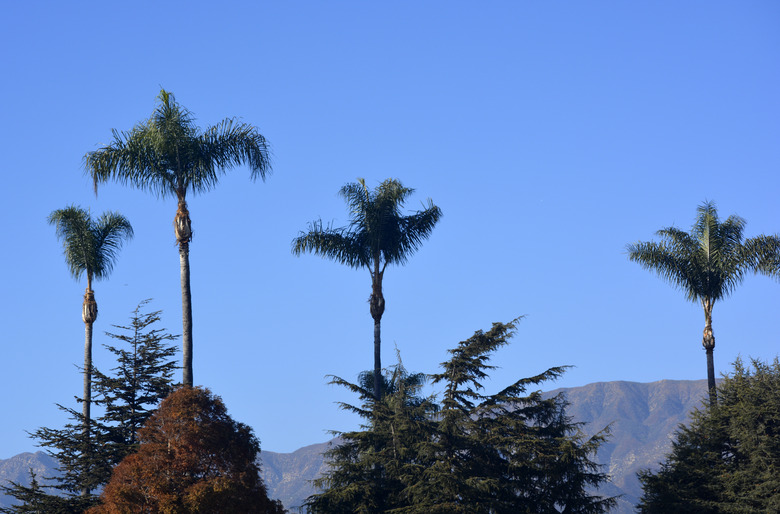How To Stop A Queen Palm From Producing Seeds
We may receive a commission on purchases made from links.
With its tall, stately trunk and feathery fronds flowing in the wind, it's easy to see why queen palms (Syagrus romanzoffiana, U.S. Department of Agriculture plant hardiness zones 9 through 11) are such popular landscape trees. Despite the tropical beauty they bring to landscapes, their ripe seeds dropping to the ground are messy. Don't despair because you can alleviate this problem before it occurs.
Queen Palm Noteworthy Characteristics
Queen Palm Noteworthy Characteristics
Queen palms are stately, elegant palm trees sporting straight, smooth gray trunks. The palm averages around 50 feet tall, producing 2 feet of new growth yearly. The palm has a fast growth habit. Unlike many types of palms producing multiple trunks, queen palms are single-trunk specimens.
Mature queen palms produce a crown that can achieve a spread of 20 to 25 feet filled with long, flowing fronds. The palm's glossy-green, 10- to 15-feet-long feathery fronds flow gracefully in the wind. Queen palms don't contain thorns, so you won't have to worry about being poked while working around the tree. Trees have an evergreen habit.
During spring and summer, long inflorescences form among the fronds that contain white flowers. Once spent, the flowers turn into massive clusters of orange 1-inch seeds. The orange coating covering the hard inner seeds is fleshy. Mature seed clusters can contain over a thousand seeds and can weigh over 100 pounds. Once ripe, the seeds eventually drop to the ground below the palm, creating a mess, attracting insects like fruit flies and developing unwanted seedlings.
Properly Pruning Fronds and Seeds
Properly Pruning Fronds and Seeds
To maintain a queen palm's proper health, it's important to prune at the correct time, as improper pruning negatively affects the tree's health. Queen palms are not self-cleaning, so it's up to the gardener to prune off the dead fronds. However, use caution when pruning tall queen palms or hire professionals to do the job since they have equipment to safely reach the top of taller specimens.
As with all types of palms, it's important to wait until the frond is completely brown and dead before removing it from the tree. Even if the frond is slightly green, the queen palm is still receiving nutrients from the frond. Once the frond has completely died, you can trim it from the palm without negatively affecting the tree's health.
However, when it comes to the developing seeds, you can trim the inflorescence from the queen palm at any time. Pruning an immature inflorescence from the tree before it produces the seeds makes the job a bit easier and prevents the ripe seeds from creating a stinky cleanup job. You can prune off the inflorescence at any stage of development without fear of negatively affecting the palm's health.
Basic Growth Requirements and Propagation
Basic Growth Requirements and Propagation
Queen palms perform best when planted on well-draining soils that aren't alkaline and in a site situated in full to partial sun. Consider the tree's mature height and spread when selecting a permanent location. During the first year of growth, water the palm regularly to produce a deep root structure. After the queen palm establishes itself in its new planting site, you can cut back watering to once every week or so, as the tree is moderately tolerant to drought. Fertilize in spring with a general-purpose blend specific to palm trees.
You can easily propagate new queen palms by sowing the ripe seeds. Scrape off the bright-orange coating covering the seeds and then soak them for several days. After soaking, sow the seeds about an inch deep in a fertile, well-draining potting mix. Queen palm seeds germinate best in temperatures of 90 degrees Fahrenheit and above, and it can take anywhere from six weeks to six months for germination to occur.
